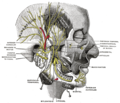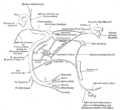Lingual nerve
Lingual Nerve
The Lingual Nerve is a branch of the mandibular nerve (the third division of the trigeminal nerve), which supplies general sensory innervation to the anterior two-thirds of the tongue. It is a key component of the oral cavity's sensory and motor system.
Anatomy[edit]
The lingual nerve originates from the mandibular nerve near the mandibular foramen. It travels anteriorly and medially, passing between the medial pterygoid muscle and the mandibular ramus. It then runs beneath the mucous membrane of the mouth floor and continues forward to the tongue.
Function[edit]
The lingual nerve provides general sensory innervation to the anterior two-thirds of the tongue, including touch, temperature, and pain sensations. It also carries taste fibers from the anterior two-thirds of the tongue via the chorda tympani nerve, a branch of the facial nerve.
Clinical Significance[edit]
Damage to the lingual nerve can result in lingual nerve injury, which can cause numbness, pain, or altered sensation in the tongue. This can affect speech, eating, and taste. Lingual nerve injury is a potential complication of dental procedures, particularly lower third molar (wisdom tooth) extraction.
See Also[edit]
References[edit]
<references />
|
|
|
Lingual_nerve[edit]
-
Lingual nerve anatomy
-
Lingual nerve in relation to the tongue
-
Lingual nerve and surrounding structures
-
Lingual nerve pathway
-
Lingual nerve and mandibular nerve
-
Lingual nerve and its branches
-
Lingual nerve
-
Lingual nerve
-
Lingual nerve
-
Lingual nerve
Ad. Transform your life with W8MD's Budget GLP-1 injections from $75


W8MD offers a medical weight loss program to lose weight in Philadelphia. Our physician-supervised medical weight loss provides:
- Weight loss injections in NYC (generic and brand names):
- Zepbound / Mounjaro, Wegovy / Ozempic, Saxenda
- Most insurances accepted or discounted self-pay rates. We will obtain insurance prior authorizations if needed.
- Generic GLP1 weight loss injections from $75 for the starting dose.
- Also offer prescription weight loss medications including Phentermine, Qsymia, Diethylpropion, Contrave etc.
NYC weight loss doctor appointmentsNYC weight loss doctor appointments
Start your NYC weight loss journey today at our NYC medical weight loss and Philadelphia medical weight loss clinics.
- Call 718-946-5500 to lose weight in NYC or for medical weight loss in Philadelphia 215-676-2334.
- Tags:NYC medical weight loss, Philadelphia lose weight Zepbound NYC, Budget GLP1 weight loss injections, Wegovy Philadelphia, Wegovy NYC, Philadelphia medical weight loss, Brookly weight loss and Wegovy NYC
|
WikiMD's Wellness Encyclopedia |
| Let Food Be Thy Medicine Medicine Thy Food - Hippocrates |
Medical Disclaimer: WikiMD is not a substitute for professional medical advice. The information on WikiMD is provided as an information resource only, may be incorrect, outdated or misleading, and is not to be used or relied on for any diagnostic or treatment purposes. Please consult your health care provider before making any healthcare decisions or for guidance about a specific medical condition. WikiMD expressly disclaims responsibility, and shall have no liability, for any damages, loss, injury, or liability whatsoever suffered as a result of your reliance on the information contained in this site. By visiting this site you agree to the foregoing terms and conditions, which may from time to time be changed or supplemented by WikiMD. If you do not agree to the foregoing terms and conditions, you should not enter or use this site. See full disclaimer.
Credits:Most images are courtesy of Wikimedia commons, and templates, categories Wikipedia, licensed under CC BY SA or similar.
Translate this page: - East Asian
中文,
日本,
한국어,
South Asian
हिन्दी,
தமிழ்,
తెలుగు,
Urdu,
ಕನ್ನಡ,
Southeast Asian
Indonesian,
Vietnamese,
Thai,
မြန်မာဘာသာ,
বাংলা
European
español,
Deutsch,
français,
Greek,
português do Brasil,
polski,
română,
русский,
Nederlands,
norsk,
svenska,
suomi,
Italian
Middle Eastern & African
عربى,
Turkish,
Persian,
Hebrew,
Afrikaans,
isiZulu,
Kiswahili,
Other
Bulgarian,
Hungarian,
Czech,
Swedish,
മലയാളം,
मराठी,
ਪੰਜਾਬੀ,
ગુજરાતી,
Portuguese,
Ukrainian












